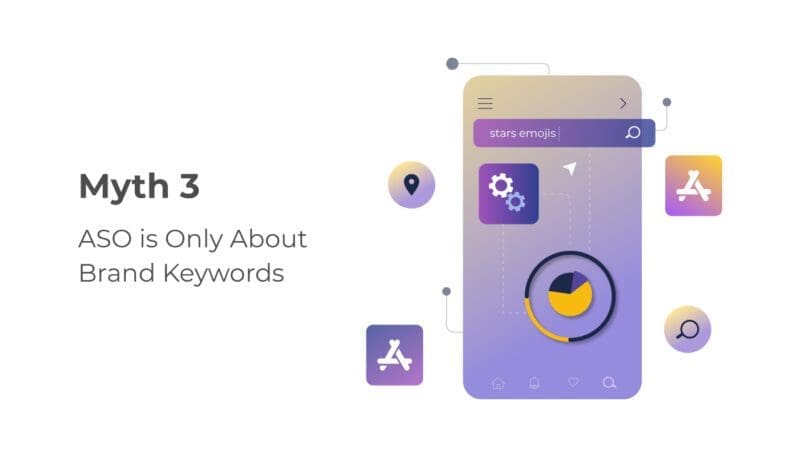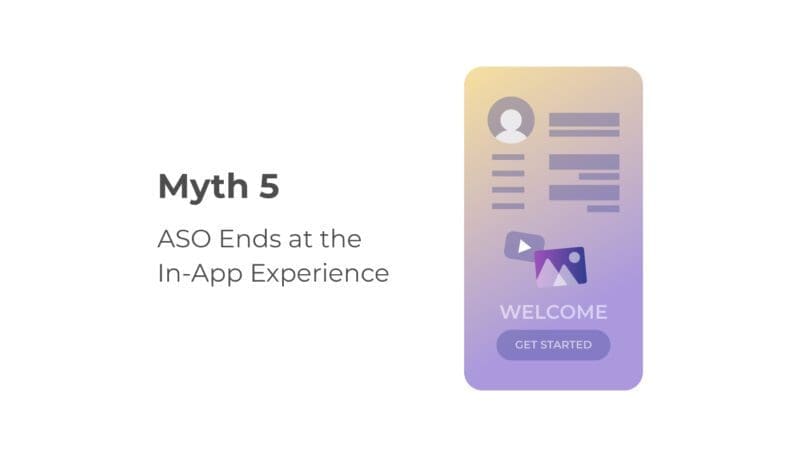App Store Optimization (ASO) is the secret behind the most successful apps in the digital marketplace. It’s the process of optimizing various elements of your app’s listing on the Apple App Store, Google Play Store, or other platforms to improve its visibility and conversion rate.
Table of Contents
In simpler terms, ASO aims to make your app easier to find and more enticing to download. It encompasses everything from keyword optimization and compelling visuals to user reviews and ratings.
Why Nailing ASO is Critical
The global app ecosystem is booming, projected to reach an astronomical valuation of $755.50 billion by 2027. ASO isn’t just a trend; it’s a critical component of long-term app growth strategy. Failing to get ASO right could mean languishing in obscurity, regardless of how good your app actually is.
The Biggest Myths About ASO
Myth 1: Constantly Changing App Title Boosts Ranking

The first myth surrounds the belief that frequently changing your app title will automatically catapult your app to higher rankings within the app store. This myth likely originates from the SEO (Search Engine Optimization) world. In SEO updating content can signal freshness to search engines like Google. However, the dynamics of app stores are different.
Firstly, changing your app title too often can confuse your existing user base. This can lead to making it harder for word-of-mouth recommendations to take effect. If the name keeps changing, how will your current users refer the app to others? Secondly, each time you change the title, you risk breaking any inbound links from sites that point to your app: This can weaken your overall ASO strategy.
Consistency and brand recognition are incredibly valuable in the crowded app marketplace. A stable, easily recognizable app title not only builds brand equity but also accumulates weight in app store algorithms over time. The best practice is to choose a title that includes a brand name and a concise, relevant description with targeted keywords.
Myth 2: One-Size-Fits-All Strategy Works for Both iOS and Android

The belief that what works for Apple’s App Store will work identically for Google Play (or vice versa) is fundamentally flawed. Each platform has its own set of rules, algorithms, and audience behaviors. For example, the Apple App Store uses the title and the subtitle for keyword indexing. Google Play only considers the app title and the backend keywords you provide. The character limits are also different, Apple allows only 30 characters for the title and Google up to 50.
To maximize your ASO strategy, tailor your approach for each platform. Analyze the specific ranking factors and character limits unique to each store. You may have to abbreviate your app title for the Apple App Store, but you could take advantage of extra characters on Google Play to include more keywords.
Myth 3: ASO is Only About Brand Keywords
 Many developers mistakenly think that optimizing for brand keywords is the end-all, be-all of ASO. While brand terms are essential as your app gains popularity, they are just the tip of the iceberg. Relying solely on them limits your visibility among users who are not yet familiar with your app.
Many developers mistakenly think that optimizing for brand keywords is the end-all, be-all of ASO. While brand terms are essential as your app gains popularity, they are just the tip of the iceberg. Relying solely on them limits your visibility among users who are not yet familiar with your app.
Broaden your keyword strategy to include generic terms related to your app’s functionality, as well as competitor keywords. A balanced approach to keyword optimization exposes your app to various search queries, increasing its visibility and, consequently, its potential user base. Use analytics to track how different keywords perform over time and adjust your strategy accordingly.
Myth 4: ASO Tools are All You Need

ASO tools can provide valuable insights into keyword performance, competitor analysis, and market trends. However, the myth that these tools alone can solidify your ASO strategy is misleading. ASO is an ongoing process that requires constant tweaking and a blend of various tactics.
ASO tools offer essential metrics and insights, they should complement a holistic marketing strategy that includes user acquisition campaigns, paid social media marketing, and in-app analytics. Fine-tuning your app based on real user behavior and feedback will provide a more comprehensive approach to ASO.
Myth 5: ASO Ends at the In-App Experience

Many developers believe that once a user has downloaded their app, the role of ASO is over. This notion is severely misguided. User engagement and retention metrics are increasingly becoming vital factors that app stores consider when ranking apps. A high churn rate or low user engagement can drastically affect your app’s visibility in the long term.
The in-app user experience is a critical part of ASO. Factors like app loading time, intuitive UI/UX design, and the value your app provides contribute to metrics like user engagement, session length, and churn rate. Neglecting the in-app experience can result in poor reviews and low engagement, which in turn will hurt your app’s ranking in app stores. Therefore, ASO is a continuous, evolving process that doesn’t end after the download.
Conclusion: Beyond Myths—The unexplored territories of ASO
Dispelling myths is only the first step in the journey toward mastering ASO. While it’s critical to correct misguided beliefs and practices, the essence of ASO goes beyond disproving falsehoods. The myths we’ve debunked serve as cautionary tales that emphasize the necessity for an informed, nuanced approach. But what happens once these myths are dispelled? What lies ahead for ASO in a constantly evolving digital landscape?
Future iterations of ASO may involve predictive analytics, integrating real-time user behaviors, or even tapping into augmented and virtual realities to enhance app discoverability. These advancements will require us to continually update our understanding and adapt our strategies, proving that ASO is not a “set it and forget it” operation.
Therefore, once you move past the myths, you find an evolving discipline that will continuously challenge your adaptability and strategic foresight. Your ability to adapt to these shifts will be the real differentiator in making your app not just visible but invaluable to users.
By demystifying common ASO myths, you pave the way for a deeper understanding and more effective utilization of this critical growth tool. But remember, the myths are the tip of the iceberg, and the best is yet to come. As technology evolves, so will ASO. And in this evolutionary journey, only those who are well-prepared and adaptable will thrive.
If you are thinking about starting this journey, remember you don’t have to do it alone. Get in touch with us and our experts can guide you to ASO success.





